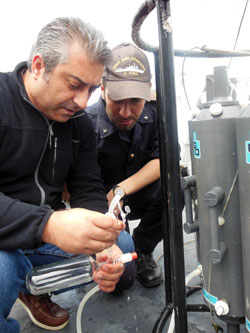The Italian Navy for the Marine Environment
The Italian Navy provides a relevant contribution to the
marine monitoring in order to ascertain the quality of national and international waters.
The Navy's work is especially important on the high seas, where for other authorities, scientific institutes and organizations involved in marine conservation, it's more difficult to operate.
Besides the special navy units of the Naval Fleet – 6 patrol vessels specialized in anti-pollution operations (units of the Costellazioni class, first and second series of the Patrol Forces Command based in Augusta – COMFORPAT) – all of the Navy units have among their secondary tasks marine conservation especially through the control of hydrocarbons spills in the sea (Legislative Decree: 6 nov 2007 n.202, art. 12), cetaceans monitoring and detecting of microclastic sediments.
The Marine Strategy Program lately provides an even more tangible contribution to the marine monitoring. The Navy is giving specific attention to environmental issues and its work benefits the Country, the European Union and the scientific community involved in oceans habitat and environment conservation.
The Marine Strategy
The European Community, as per the regulation 2008/56/CE, entrusted the EU countries with creating national strategies involving all the main naval institutions, aimed at marine conservation.
Italy applied this regulation with the Legislative Decree 13 ottobre 2010, n° 190 which gives the Ministry of the Environment and Protection of Land and Sea of Italy (MATTM) the role of coordinator of the strategy through the
Technical Committee for the Environmental Marine Strategy (c.d. Marine Strategy).
To this national committee belong the representatives of the ministries active in the marine conservation, including a representative of the Italian Navy, as a permanent delegate of the Ministry of Defence. In particular, on a technological-operative basis, the national Marine Strategy is achieved in five steps:
- Evaluation of the current state of the national waters (completed);
- Targeting: the Good Environmental Status – GES (completed);
- Targeting the "marine environmental goals" (TARGET) which allow to reach the GES (completed);
- Elaboration of the monitoring programs, evaluating the quality of the marine environment (in progress);
- Elaboration of the actions needed to reach the reach the GES and maintain it. (To be established).
The initial evaluation of the state of the waters and the establishing f the parameters that earn a GES (indicating the good environmental status) have been defined on the basis of eleven specific parameters, given by the European Commission and named 'Descriptors'. The systematic monitoring of these descriptors will constitute the National Plan for Environmental Monitoring and will allow to target environmental goals which in turn will earn a GES.
The Institute for Environment Protection and Research (ISPRA), on behalf of the Ministry of the Environment, Land and Sea, issued the National Monitoring Plan ("
Architettura per il Piano Nazionale di Monitoraggio") which identifies the Descriptors and the monitoring operational activities.
The Technical Committee will have to elaborate the necessary measures to get and maintain the GES and communicate them to the European Commission before December
31st 2015.
The Italian Navy's Contribution to the Marine Strategy
The Italian Navy collaborated to the establishing of the GES, the marine environmental goals and the monitoring plans in different fields of the marine conservation. Among these:
- seabed and biodiversity habitat;
- environmental and hydrographic evaluation;
- underwater noise.
As for the marine monitoring, the Navy's contribution will provide logistic support with ships and other means operative in both coastal waters and offshore, and the specific skills of technical departments such as the Italian Navy Hydrographic Office in Genoa and the Naval Experimentation and Support Centre (CSSN) in La Spezia.

All of this within the dual connotation of the Italian Navy's work for Defence and Maritime Safety in the Mediterranean Sea.
In particular, the Italian Navy can contribute to the monitoring with:
- the employ of naval units for the Descriptors' monitoring, in cooperation with the institutional activities;
- the use of the data acquired during the Hydro-Oceanographic Campaigns and data from the collaborations with the research institutes;
- provision of the hydro-oceanographic data from the Italian Navy Hydrographic Institute (IIM);
- the monitoring of the Biogenic Habitat – Cold Water Corals;
- the employ of the Hydrographic Units and the Minehunters for the control of specific parameters through the use of multibeam echo sounding, side scan sonars, grabs, ROVs and AUVs;
- specific expeditions and hydrographic research;
- acquisition of acoustic data concerning the merchant navy.